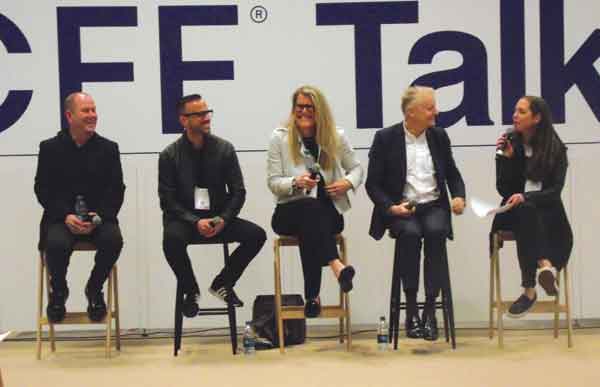At ICFF, held in New York City a few months ago, the session “Defining Luxury for Today” delved deep into the evolution of design as it applies to the luxury market. By Stef Schwalb
Compared to how this segment of hospitality was defined decades ago, it is now changing at a rapid pace. A panel of leading industry experts who frequently create luxury spaces for premier hotels, casinos, and resorts revealed their insights on current trends and cited the one element above all else that is having a critical impact in the design process today: The consumer’s desire for authentic experiences.

The panel was comprised of Margaret McMahon, Senior Vice President/Managing Director of Wimberly Interiors; Greg Keffer, Principal + Studio Leader of The Rockwell Group; Glenn Pushelberg, Co-Founder of Yabu Pushelberg; and Ted Jacobs, VP/Global Design at W | St. Regis | The Luxury Collection Starwood Hotels & Resorts.
“Luxury is no longer grand spaces or materials,” stated Pushelberg at the top of the session. “That’s over, in a classical sense. The old model of [achieving] 4 or 5 stars is finished. Now everybody wants to be somewhere ‘special,’ so you have to think about how people live and how you detail it.”

From the influence of AirBnB accommodations and private membership co-working spaces that espouse community building and exclusivity to obsessive Instagram food-sharing and the desire to immerse oneself in all aspects of local culture, people are taking a proactive approach of determining how they will live, work, and travel to new heights and the ways they aspire to do so. The properties leading the way are the ones adding new layers of access to these in-demand desires, instilling emotional attachments to physical spaces.
“With AirBnB,” explained McMahon, “we’ve taught homeowners how to be hoteliers. Not all of them are great, but there’s something to it and it’s not just price. There are a lot of hoteliers who use the service, so it should make the industry sit up and say how do we do this?” And it is. The company’s “Live like a local” mantra has moved from mainstream to mainstay luxury brands that are devising and revising their traditional approach.

century historic building that has been re-imagined with modern sensibilities.
“Authenticity in locale has big influence,” added Keffer. “You need to deep dive into cultural, physical, and social aspects of a place, making the inclusive exclusive.” While the exterior environment plays a critical role in channeling the “realness” of a region, it is also important to ensure the interior experience is fluid throughout — from the biggest details to the smallest.
“To make a great party, you need interesting and different people with commonality. The best hotels transcend segmentation and have a mixed social center,” explained Pushelberg. “It’s a combination of things that make people want to spend more money to stay somewhere. There is a value to favorite hotels, like The London Edition. There are different aesthetics. You can’t throw the same party twice.” This is especially true when it comes to dining, which has evolved tremendously in the luxury experience from what was traditionally expected and accepted in the past.
“The world today is a sharing community. We love our Instagram. We love our Facebook. We love that it connects people around the world instantaneously with things that they wouldn’t normally be exposed to,” Keffer remarked. “That is influencing dining, how you experience different foods, different chefs, and how you engage different communities that aren’t just your immediate instant go-to’s.”
“Authenticity is the driver,” Jacobs concurred. “It used to be a traditional restaurant with a separate door and white tablecloths. Food has evolved to be much more authentic. It’s not about tablecloth. It’s more about the $7 best thing you ever had vs. $300 gastro-chemistry.” While authenticity may be the end game, luxury still remains truly defined by ensuring every step of the consumer’s experience is accounted for.
“I just got back from Dubai. We can all attest that we notice when the service isn’t consistent. It’s the one thing that gets to me,” revealed McMahon. “We always tell our clients that we can create an environment that feels like luxury and looks like luxury, but if you don’t follow that up with service that’s commensurate of what that brand is, then you’ve just lost it. That, for us, is the biggest challenge.” The panel was in agreement that this speaks to the issue and importance of defining brand.
“Is brand being an experience or a logo?,” inquired Jacobs. “Unfortunately. some of what we are seeing in the hospitality industry as the definition is the logo and the logo drives rate. [As in] if I put this logo on the side of a building, I can get this much per night. That’s very unfortunate and it’s fairly unique to the hospitality industry. If you look at the retail industry there’s this thing called control — and every great brand has control. Do you think Apple allows its operators to do what they want? No. How about car dealerships? When Toyota rolls [a dealership] out, it must be consistent with what their strategy and vision are or they don’t get cars.”
“The difference between Apple and Toyota versus hotels is we don’t want that level of consistency. We want the level of experience, so it’s intangible,” added Pushelberg. “That’s where we want consistency — in experience. The old-fashioned brand hotels had to be [a certain square footage]. All of these dictates are artificial and don’t substantiate anything. Instead, talk about the true narrative that’s informative to your design. I think that, ultimately, what the consumer wants is choice. There is a strategy of giving people choices today. Once you do that, you satisfy their needs rather than imposing upon them.”





